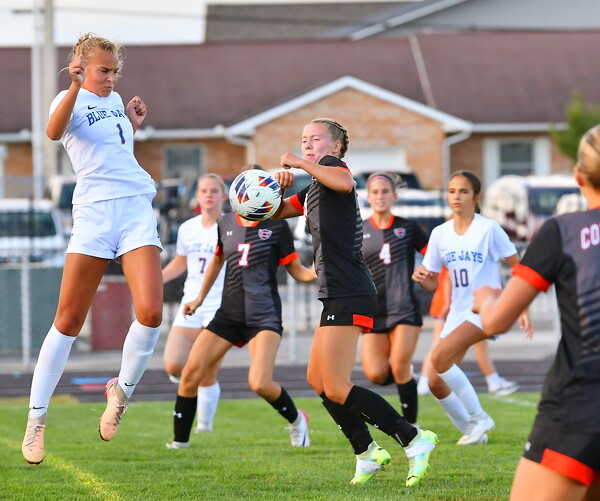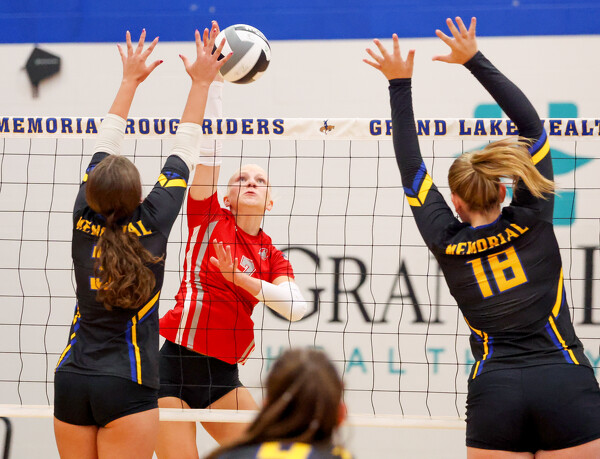
A Celina graduate peruses her cell phone before commencement in 2024.
CELINA - The implementation of a new state law banning cellphones in public school classrooms is underway in the Grand Lake region, with most area administrators reporting little to no issues, and a lot more productivity.
State legislators previously passed a law requiring schools to have student phone policies in place by the 2025-26 school year. However, the state's biennium budget, House Bill 96, signed into law in late June, included a provision prohibiting student cellphone use during instructional periods in public schools.
The new law didn't come as a surprise. A separate bill, Senate Bill 158, was also working its way through the state legislature this year and would have generally prohibited student cellphone use in public schools.
In addition, Gov. Mike DeWine has been adamant during his tenure that cellphones do not belong in schools. First, he and then Lt. Gov. John Husted strongly encouraged Ohio districts to adopt a local policy to eliminate phone use during the school day in 2024. Then in April, DeWine officially called for an outright ban.
"It's clear that we need to get cell- phones out of our classrooms," said DeWine at the time. "The constant distraction of cellphones makes it nearly impossible for students to focus and learn. Not only do they negatively impact student performance, but they can also be harmful to kids' mental and emotional health."
He also cited various research that found implementing restrictive cellphone policies in schools can impact mental health and educational outcomes, including an increase in productivity, a reduction in bullying and an increase in girls' grade point averages.
The new Ohio law requires each school district, community school and STEM school to adopt a policy prohibiting cellphone use by students during the instructional day by Jan. 1, 2026, according to education.ohio.gov. An "instructional day" is any period of time in which a student is expected to be in attendance and includes not only formal instruction time but also supervised activities, such as transitioning between classes, recess, meal periods and field trips.
Districts and schools can also prohibit students from carrying cellphones on school property. They can prohibit the use of all electronic communication devices, like cellphones, smart watches and other devices powered by batteries or electricity and that are capable of receiving and transmitting communications.
But it does include some exceptions. Those include allowing students to use their devices for purposes related to monitoring or addressing health concerns; for a student's individualized education program (IEP); for student learning; or during an active threat or emergency. Also, if a student has a written statement from a doctor requiring the use of a cellphone to monitor a health concern, the district or school must allow the student to use a cellphone for that purpose.
Though just a week into the new policy, St. Marys City Schools superintendent Bill Ruane said there have been few to no issues with its enactment.
"The students seem to be following the policy and doing a good job with it. The staff and administrators have been impressed and have noticed better focus, student engagement and interactions," he said. "A student even commented that they felt less outside pressure throughout the day and could focus on just being a student and at school for once."
In previous school years, St. Marys' policy wasn't much different. Students were only allowed to use their cellphones before and after school, and at lunch, Ruane said.
"Not having them at lunch is the biggest difference. We have already noticed an increase in the volume and loudness in the MS/HS lunch, and that is probably a good thing," he said. "Kids are talking and interacting more, which is definitely a positive."
St. Marys' new policy requires middle and high school students to put their electronics away in their lockers at all times between the morning and final bells. Students in kindergarten to fifth grade are also prohibited from having cellphones or smart devices on them during the school day.
Other local schools are taking a different approach to the required cellphone bans. At Coldwater Exempted Village Schools, high school students must place their silenced electronics in a designated pouch when entering each classroom, including study halls, superintendent Doug Mader said.
High schoolers at Coldwater may briefly check phones during transitions for essential messages, and may use them at lunch because of the district's open lunch structure, which allows high school students to leave campus. Earbuds are restricted to academic use on school-issued devices, like Chromebooks.
Cellphones are banned entirely in Coldwater's elementary and middle schools, Mader added.
Minster Local Schools adopted a similar, less restrictive policy, several years ago, high school principal Austin Kaylor said.
"Our policy focuses on students not accessing their devices during instructional periods and lunch. Students have a chance to check their phones briefly between periods - provided they aren't disrupting hallway traffic or using them for any other unauthorized purpose," Kaylor added. "We created this policy four to five years ago and it is consistent with the spirit and requirements of the new state law. We feel it strikes a good balance and helps students learn responsible use habits they can carry into adulthood."
Mader also emphasized the district's desire to remain in accordance with state law, while also allowing cellphone use in moderation.
"If the law continues to define the restriction as applying to 'instructional time,' it allows us to keep classrooms free of distractions while also teaching students moderation. That balance matters," Mader said. "Parents still need to be able to send an emergency message or communicate logistics with their child, and our policy allows for that during brief transition periods or lunch. In my view, this approach enforces focus where it matters most - in class - while still reflecting the real-world need for communication between home and school."
The Coldwater school board has purposefully not formally approved of the new policy yet.
"We are intentionally holding off on formal adoption until closer to that date to ensure we can respond if the state amends or clarifies its position under H.B. 96 or Ohio Revised Code 3313.753," Mader said.
Other area schools, such as Parkway Local Schools, have implemented all-out cellphone bans similar to St. Marys.
Parkway's policy, which requires kids to stow their electronic devices away during the school day, was implemented in 2024 and is meant to support student learning and well-being, superintendent Laura Young said.
"This change was made to help reduce distractions, improve classroom engagement, and encourage face-to-face interactions." she said. "While technology remains an important educational tool, Parkway is committed to creating a learning environment where students can stay focused and connected with one another in meaningful ways."
Most area districts don't see the new phone ban getting in the way of classroom instruction, as most students are one-to-one with Chromebooks. Ruane said St. Marys is currently working through issues related to the limited times when cellphones were previously used in class for instruction purposes.
"With our district being a one-to-one district utilizing Chromebooks for every student (in grades) sixth to 12th and one-to-one access for students (in grades) kindergarten to fifth, this shouldn't create many issues," he said. "Most (issues) had more to do with special classes or programs that required communication and sharing of work schedules or verifying hours."
Another potential kink in the new law that will require some adjustments is parent-child communication.
"Parents want to be able to get ahold of their kids in cases of emergencies whether it be weather, violence, etc.," Ruane said. "As a society, we have become accustomed to instant and continuous access to others. It will take some getting used to and some patience with leaving messages and getting delayed answers and responses."
He continued that St. Marys' safety measures and capabilities with communication have increased substantially in the past several years, so in the case of emergencies, there should not be issues with getting quick information to those that need it.
Overall, local administrators believe some restriction on the use of electronic devices during the school day was necessary to preserve a classroom learning environment.
"This removes a big barrier which should improve student growth and achievement," Ruane said. "As an adult, when you are at work or in a meeting or presentation and you have your cellphone, you know how distracting they are to your focus. This is even more so with students when you add in TikTok, Snap Chat and other social media and pressures students face daily from their peers."

